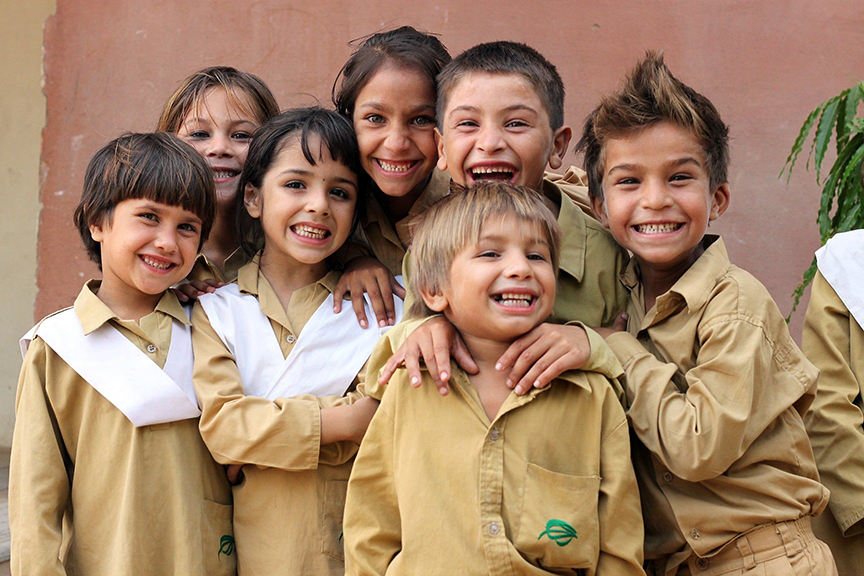Open sewers and lines of garbage clutter around the broken road. Barefoot children play in dirty puddles along with buzzing flies and tired-looking dogs. The houses are small, makeshift, with narrow doorframes and no doors. This isn’t a picture limited to one location – there are hundreds of thousands of such villages and slums all over Pakistan, a country where 22 million people live below the poverty line.
It is in some of these most deprived localities of the country that you come across the bright blue gates of schools that open to reveal beautiful brick-and-mortar buildings. The schools are spacious, clean, colourful and airy. They are in stark contrast to the dismal surroundings in which they stand.
The classrooms have proper furniture and wide open windows, there is a teacher in every class and books on all the desks.
This is not an ordinary situation in a country that has the second-largest out-of-school population in the world (www.worldbank.org). The public sector has utterly failed to focus on education. Even in places where there are government schools, the scene inside is heart-breaking: missing teachers, broken furniture, three to four children squashed together on one desk and a stifling, dreary environment.

“Everything related to education is a step forward, whether it is under a tree, in a garage or in a tent,” says Ateed Riaz, member of the directors’ board and co-founder of The Citizens Foundation. “However, we felt that since we ourselves are a product of formal education, we will build our institution along the same lines. We will create schools which are properly built. We were confident about our decision and there was never any hesitation or doubt regarding the path we have chosen.”
Which is why the schools built by The Citizens Foundation (TCF) are different. TCF is Pakistan’s largest education non-profit, which provides low-cost, quality education to some of the most deprived areas in the country.
TCF schools are meticulously planned structures relying on solid, open architectural designs and are a physical realization of the philosophy that all our children deserve the best. In addition to classrooms, every school has a playground, staff room, library and canteen.
“My school has a big playground. I play all types of games [there] with my friends!” says Shakir, an enthusiastic fifth grader at TCF’s school in Rehri Goth, a fishing village on the outskirts of Karachi.
The ground doesn’t just provide children with a place to practice cricket. It is instrumental for the school’s Physical Education (PE) program and other co-curricular activities. Significant research documents the importance of co-curricular activities for children’s healthy and wholesome development. Similarly, each school has a library that is furnished with a set of books encompassing fiction, literature, history and other genres. The library is a place where children can be surrounded by imagination and colour, and a love for reading can be inculcated in them.
There are separate toilets for girls and boys. Research indicates that if there are separate toilets available for girls, they are more likely to attend in the first place as well as stay on and complete their education (‘Women and Girls and their right to Sanitation’, July 2012). Similar research in African schools showed that lack of clean water and separate toilets for girls and boys were major barriers to school attendance, especially in the case of girls. All TCF schools ensure that there is clean drinking water for their staff and students.
In the secondary schools, there are also computer laboratories. The staff spends hours putting up educational posters and charts, painting numbers and alphabets on the walls and showcasing student artwork on bulletin boards in the corridors. When you walk into a TCF school, you will feel an almost physical joy. The destitution outside melts away and the warm, colourful environment of the school envelops you with hope.
“The first time I walked into the TCF school, I saw the big walls and the pretty charts and a wish came to my heart – please Allah, let me get into this school!” says Anum Fatima, a student who graduated from a TCF school in 2007 .

Significant research has pointed out that the physical environment of a school has a profound impact on students and staff. A clean, quiet and colourful environment leads to better learning outcomes (K.A. Graetz; Earthman, G, 2004). It makes intuitive sense – children will learn better when they are not crammed onto broken benches with unpainted, peeling walls and scratched up black boards. Schools have to be places that students want to go to. The kind of environment that TCF strives to provide does just that. Research also says that a positive environment helps students create emotional bonds with their school.
“TCF schools are built keeping in mind the specific environment and its needs, and using local material to keep costs low,” explains Saleha Ahmed, an architect who works in the Engineering department at TCF. This is why you will see that the schools in Punjab are made with red bricks, the ones in urban parts of Sindh are concrete and the schools in Azad Kashmir are earthquake resistant. All of them follow open designs to allow for an airy, spacious feel.
All children have a right to nutrition, housing, safety, education and happiness. Too many of Pakistan’s children do not have even the most basic amenities of life. In the case of 165,000 children, TCF steps in and provides them a lovely building in which they can learn, prosper and grow. It creates an environment in which children have the courage and will to dream bigger, inspiring a confidence in students that makes the twinkles in their eyes even brighter.
References:
http://www.educause.edu/research-and-publications/books/learning-spaces/chapter-6-psychology-learning-environments
http://www.un.org/en/events/toiletday/pdf/Planners-Guide-Fact-Sheet-3_English.pdf
http://www.unicef.org/esaro/5481_education_gender.html





